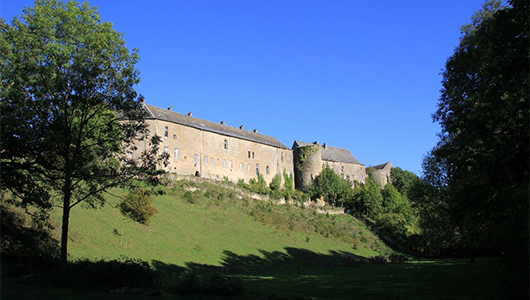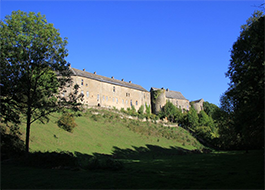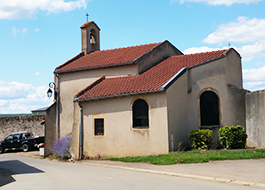Roussy-le-Village
Durée visite : 20 minutes
Moyen : Pédestre
En 1036, la terre de Roussy appartenait probablement tout entière à Adalberon, fils de Sigefroy, fondateur de Luxembourg. Vers 1236, Roussy fut partagé. Son vaste territoire devint la propriété pour la plus grande partie de la comtesse Ermesinde. Elle destina cette terre comme part d’héritage de l’un de ses descendants. C’est cette part qui fut nommée plus tard le comté de Roussy. Une autre partie est demeurée en la possession d’un membre de l’ancienne famille de Roussy. Ce fut cette part qui continua de porter le nom de seigneurie de Roussy. Elle devint en 1287 un apanage de la branche de Luxembourg-Ligny. Puis en 1471, elle passa au seigneur de Rodemack. Occupée par la France en 1680, Roussy devint Française en 1769. La Révolution marque la fin officielle du comté et de la seigneurie de Roussy. Depuis 1811, Roussy-le-Village et Roussy-le-Bourg ne forment plus qu’une seule commune. Le village est libéré en 1944 par le général Patton.
In 1036, the land of Roussy probably belonged entirely to Adalberon, son of Sigefroy, founder of Luxembourg. Around 1236, Roussy was divided. Its vast territory became the property for the greater part of Countess Ermesinde. She intended this land as part of the inheritance of one of her descendants. It is this part which was named later the county of Roussy. Another part remained in the possession of a member of the old Roussy family. It was this part that continued to bear the name of the seigneury of Roussy. In 1287 it became a prerogative of the Luxembourg-Ligny branch. Then in 1471, it passed to the Lord of Rodemack. Occupied by France in 1680, Roussy became French in 1769. The Revolution marks the official end of the county and the seigneury of Roussy. Since 1811, Roussy-le-Village and Roussy-le-Bourg have become a single municipality. The village was liberated in 1944 by General Patton.
Im Jahr 1036 gehörte das Land Roussy wahrscheinlich vollständig Adalberon, dem Sohn von Sigefroy, dem Gründer von Luxemburg. Um 1236 wurde Roussy geteilt. Sein weites Gebiet wurde Eigentum des größten Teils der Gräfin Ermesinde. Sie beabsichtigte dieses Land als Teil des Erbes eines ihrer Nachkommen. Es ist dieser Teil, der später die Grafschaft Roussy genannt wurde. Ein anderer Teil blieb im Besitz eines Mitglieds der alten Familie Roussy. Es war dieser Teil, der weiterhin den Namen des Seigneury von Roussy trug. Im Jahr 1287 wurde es ein Appanage der Niederlassung von Luxemburg-Ligny. Dann, im Jahr 1471, ging es an den Herrn von Rodemack über. Roussy wurde 1680 von Frankreich besetzt und 1769 französisch. Die Revolution markiert das offizielle Ende der Grafschaft und das Seigneury von Roussy. Seit 1811 sind Roussy-le-Village und Roussy-le-Bourg eine einzige Gemeinde. Das Dorf wurde 1944 von General Patton befreit.

D’argent au lion de gueules à double queue, couronné, armé et lampassé d’or.
Ce sont les armes de l’ancien comté de Roussy.
Argent to the lion Gules with double tail, crowned, armed and langued Or.
These are the weapons of the old county of Roussy.
Argent zum Löwen Gules mit Doppelschwanz, gekrönt, bewaffnet und geschwächt.
Dies sind die Waffen der alten Grafschaft Roussy.

Die Rüttger Kiepper = les batailleurs de Roussy-le-Village.
Cet appellatif fut octroyé autrefois aux jeunes gens de cette localité, car à toutes les kermesses et aussi à d’autres occasions, il y était coutume de se mesurer, de se quereller et se battre avec la jeunesse des alentours.
Réf. Archives municipales de Thionville (Liste de M. L. V.)
Die Rüttger Kiepper = the battlers of Roussy-le-Village.
This name was granted in the past to the young people of this locality, because at all fairs and also on other occasions, it was customary to compete, quarrel and fight with the surrounding youth.
Ref. Municipal Archives of Thionville (List of M. L. V.)
Die Rüttger Kiepper = die Kämpfer von Roussy-le-Village.
Dieser Name wurde in der Vergangenheit den jungen Leuten dieses Ortes verliehen, weil es auf allen Messen und auch bei anderen Gelegenheiten üblich war, mit den umliegenden Jugendlichen zu konkurrieren, zu streiten und zu kämpfen.
Ref. Stadtarchiv von Thionville (Liste von M. L. V.)

Les habitants et les habitantes de Roussy le Village s’appellent les Rodossyens et les Rodossyennes.
The inhabitants of Roussy le Village are called Rodossyens and Rodossyennes.
Die Einwohner von Roussy le Village heißen Rodossyens und Rodossyennes.
Les points de visites
.
L’ensemble castral est formé de deux châteaux, Roussy-Comté et Roussy-Seigneurie. Ils appartenaient en fait à deux branches de la même famille. Celle dite du Comté exerçait une justice haute, moyenne et basse. Le château de Roussy-Comté, cité dès 1131 est formé de trois corps en U sur un plan trapézoïdal. L’ensemble date de la fin du XVe au milieu du XVIIIe siècle. Il comporte une chapelle et un logis du XVIe siècle et un puits daté de 1746.
Le château de Roussy Seigneurie fut reconstruit au XIIIe siècle. Il en reste la tour Sud, dite le donjon, des courtines, deux tours Est. Les deux tours Ouest écrêtées sont reconstruites au XIVe siècle. On y trouve également un logis adossé à la courtine Ouest du XVIe siècle, un logis en partie repercé, un portail d’entrée dans la courtine Nord et un puits construit au XVIIIe siècle. Les parties agricoles sont construites au XIXe siècle.
The castle complex is made up of two castles, Roussy-Comté and Roussy-Seigneurie. They actually belonged to two branches of the same family. That known as of the County exercised a high, medium and low justice. The Roussy-Comté castle, cited from 1131 is formed of three U-shaped bodies on a trapezoidal plan. The set dates from the end of the 15th to the middle of the 18th century. It has a 16th century chapel and lodge and a well dated 1746.
The Château de Roussy Seigneurie was rebuilt in the 13th century. There remains the South tower, known as the keep, curtain walls, two East towers. The two clipped west towers were rebuilt in the 14th century. There is also a house backing onto the 16th century West curtain, a partially pierced house, an entrance gate into the North curtain and a well built in the 18th century. The agricultural parts were built in the 19th century.
Der Schlosskomplex besteht aus zwei Burgen, Roussy-Comté und Roussy-Seigneurie. Sie gehörten tatsächlich zwei Zweigen derselben Familie an. Das, was von der Grafschaft bekannt ist, übte eine hohe, mittlere und niedrige Gerechtigkeit aus. Das 1131 zitierte Schloss Roussy-Comté besteht aus drei U-förmigen Körpern auf einem trapezförmigen Grundriss. Das Set stammt vom Ende des 15. bis zur Mitte des 18. Jahrhunderts. Es hat eine Kapelle und Lodge aus dem 16. Jahrhundert und ein gut datiertes 1746.
Das Château de Roussy Seigneurie wurde im 13. Jahrhundert wieder aufgebaut. Es bleibt der Südturm, bekannt als Bergfried, Vorhangfassaden, zwei Osttürme. Die beiden abgeschnittenen Westtürme wurden im 14. Jahrhundert wieder aufgebaut. Es gibt auch ein Haus, das auf den Westvorhang aus dem 16. Jahrhundert zurückgeht, ein teilweise durchbohrtes Haus, ein Eingangstor in den Nordvorhang und einen Brunnen aus dem 18. Jahrhundert. Die landwirtschaftlichen Teile wurden im 19. Jahrhundert gebaut.
.
.
La chapelle de Sainte-Croix de Roussy-le-Bourg fut construite dans le premier quart du XVIe siècle. Elle est agrandie vers 1560, avec la construction du chœur et des bras du transept. Les baies furent repercées et la sacristie construite dans la première moitié du XVIIIe siècle. La porte du mur Sud fut transférée dans le mur Ouest en 1902 . En 1950 le campanile est transformé en clocher mur. Il existe deux autres chapelles, un oratoire et de nombreux bildstocks dans la commune. Une église est reconstruite au siècle dernier.
The chapel of Sainte-Croix in Roussy-le-Bourg was built in the first quarter of the 16th century. It was enlarged around 1560, with the construction of the choir and the arms of the transept. The bays were re-pierced and the sacristy built in the first half of the 18th century. The southern wall gate was moved to the western wall in 1902. In 1950 the campanile was transformed into a wall bell tower. There are two other chapels, an oratory and many bildstocks in the town. A church was rebuilt in the last century.
Die Kapelle von Sainte-Croix in Roussy-le-Bourg wurde im ersten Viertel des 16. Jahrhunderts erbaut. Es wurde um 1560 mit dem Bau des Chores und der Wappen des Querschiffs erweitert. Die Buchten wurden in der ersten Hälfte des 18. Jahrhunderts neu durchbohrt und die Sakristei errichtet. Das Südmauertor wurde 1902 an die Westmauer verlegt. 1950 wurde der Glockenturm in einen Mauerglockenturm umgewandelt. Es gibt zwei weitere Kapellen, ein Oratorium und viele Bildungsstöcke in der Stadt. Eine Kirche wurde im letzten Jahrhundert wieder aufgebaut.







